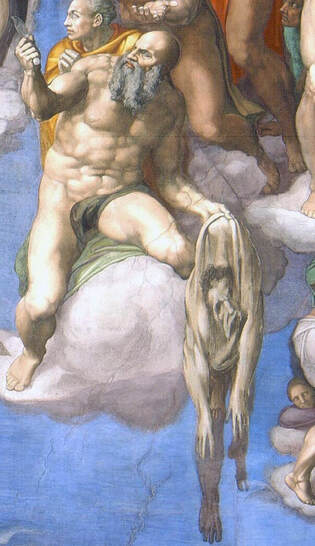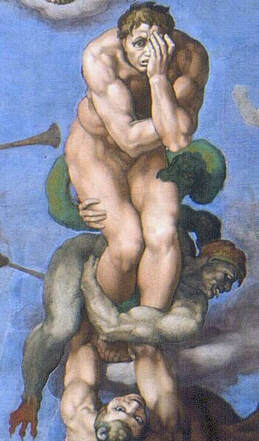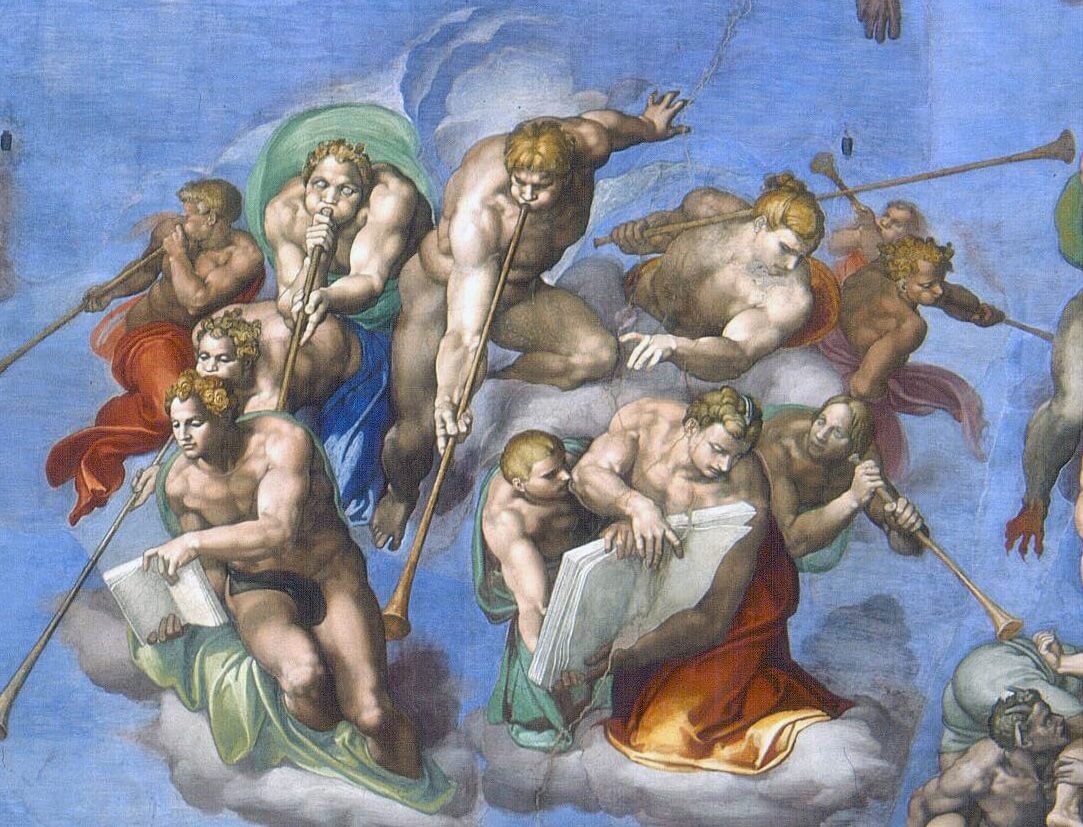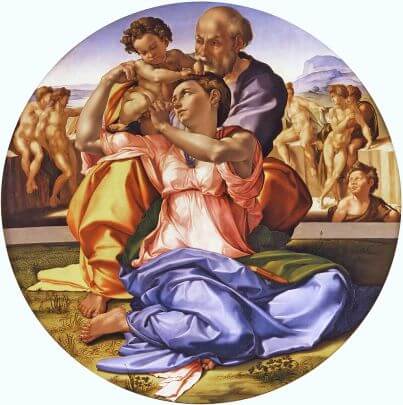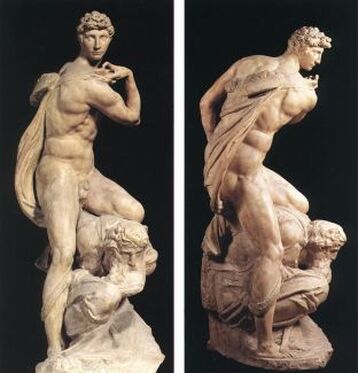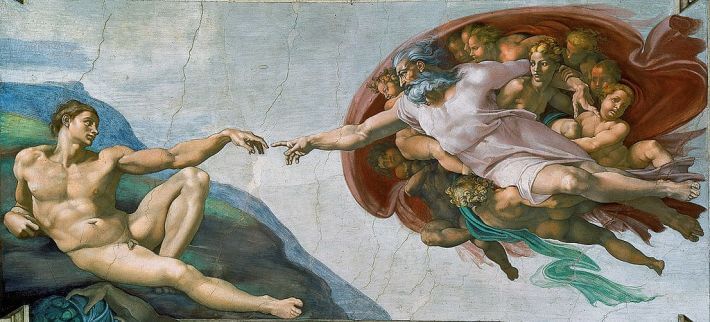|
Where? On the west wall of the Sistine Chapel in the Vatican Museums
When? 1536-1541 Commissioned by? Originally Pope Clement VII commissioned Michelangelo to paint a fresco about the resurrection, but after the death of Clement VII, Pope Paul III changed the topic of the fresco into the Last Judgment. What do you see? The painting can be divided into two scenes which are interconnected. On the top half is a scene with Jesus in the middle and on the bottom half is a scene where it is decided whether people go to Heaven or Hell. The scene surrounding Jesus: Jesus is the central figure in the top middle of the fresco. He stands on a cloud against the background of a golden aureole. He raises his right arm to condemn the people on the right of painting to Hell, and he puts his left hand forward to draw the blessed people on the left of the painting towards him. His figure has been modeled after the Apollo Belvedere which is also in the Vatican Museums. Jesus is surrounded in the top half of the painting by all sorts of saints and Biblical figures. While many of these figures cannot be precisely identified, some important ones stand out. To Jesus’ immediate left (from our perspective) is Mary with a red dress and a bright blue cloak. She looks to the blessed people on the left of the painting. She has a passive attitude as her role to intervene between the people who pray to her and God is no longer relevant.
The scene at the bottom: In the bottom left, people arise from their graves. In the scene above this one, some of these people are rising through the help of angels or clouds. These are the people that are saved.
In the bottom middle, above the cross of Jesus, there is a group of wingless angels who are blowing trumpets to awake the dead. They carry two books that contain the names of the people who are going to Heaven and Hell. The bigger book on the right contains the people that go to Hell. On the bottom right, there is a boat full of people who are going to Hell. Charon is standing on the left side of the boat and aggressively forces the people out of the boat. Minos is standing in the right bottom corner of the painting with a snake wrapped around him (and the snake bites his genitals). He is standing in front of the entrance to Hell. Charon and Minos are two figures described in Dante’s poem Inferno, and they are depicted exactly as Dante describes them.
Backstory: Michelangelo initially discussed the content of a large fresco in the Sistine Chapel with Pope Clemente VII in 1533. However, he only started to work on the actual fresco in 1536 under Pope Paul III. Before Michelangelo started his work on The Last Judgment (sometimes spelled The Last Judgement), the wall was covered by three frescos from Perugino.
Michelangelo decided that the wall should be rebuilt using high-quality brick stones and slope slightly inwards such that the wall could not collect dust. The goal of his fresco is to remember viewers of the upcoming day of the Last Judgment, where everyone, including the viewers, will be judged by God on whether they will go to Heaven or Hell. The painting caused quite some controversy when it was revealed. Controversial elements were the inclusion of mythological figures and the wingless angels in the fresco. Another important debate was about all the nudity in the fresco on the wall of a chapel. Originally the genitalia of many people in this fresco were visible. Around 1564, probably right after the death of Michelangelo, Danielle Da Volterra was ordered to cover some of these obscenities in this fresco.
Symbolism:This fresco contains lots of symbolism, and almost every attribute in the painting has a symbolic meaning. Below are a few examples.
The Last Judgment according to the Bible: The Last Judgment of all people who lived on Earth is an important aspect of the Christian religion. It is described as a moment in which all people will come to life again, and the good people will be rewarded by going to Heaven, and the evil people will go to Hell. There is a large number of references in the Bible to the Last Judgment (see here for a complete list). The most important and direct reference is in Revelations 20:11-15 in which the judgment day is described in a vision to John the Apostle. Another good source is Matthew 25: 31-46 in which Jesus explains the Last Judgment as the day when he will return to Earth with all his angels. Several main elements in this fresco can be linked to the Biblical stories. For example, the scene at the bottom left on the opening of the graves is based on Ezekiel 37:1-14. However, many aspects of this painting also differ from the Biblical description. Moreover, some elements are also inspired by non-Biblical sources, such as Dante’s Inferno. Who is Michelangelo? Michelangelo di Lodovico Buonarroti Simoni (1475-1564) was born in Caprese in the Republic of Florence. He lived most of his adult life in either Florence or Rome. From 1534 till his death he lived in Rome where he not only worked on this fresco in the Sistine Chapel, but he was also appointed lead architect of St. Peter’s Basilica. Michelangelo was an architect, painter, poet, and sculptor and he is remembered most for his paintings and sculptures. Only a few paintings of him have survived, including the Doni Tondo in the Uffizi Museum. However, he is better known for his amazing frescos such as the ceiling of the Sistine Chapel which includes the famous scene of The Creation of Adam. His sculptures are also considered to be among the best in the world. A couple of examples are his statue of David in the Galleria dell’Accademia and his Genius of Victory in the Palazzo Vecchio.
Fun fact: Michelangelo included about 400 figures in this fresco and has included these people in a large number of different positions. This required very extensive knowledge of the human body which is something Michelangelo possessed.
From a young age, Michelangelo participated in the dissection of the bodies of convicted criminals, something that the Pope allowed. The only condition was that the bodies of the criminals would be properly buried afterward. These dissections provided Michelangelo with very valuable knowledge of the human body, which was important for the realism of his sculptures and paintings. Michelangelo was not the only artists that dissected dead bodies. Multiple artists did this during that period, including Leonardo da Vinci, as the art moved away from unrealistic religious painting during the Middle Ages to more realistic and idealized human bodies during the Renaissance. Interested in a copy for yourself? Poster
Written by Eelco Kappe
References:
2 Comments
10/3/2023 12:19:58 pm
I just love this painting due to my Faith, I have the canvas version of many sizes, and I downloaded from the Internet...the highest resolution you can imagine, the store can provide up to 48x30 size at very low price
Reply
Leave a Reply. |
Categories
All
|
- Home
- Blog
-
Museums
- Alte Pinakothek
- Art Institute of Chicago
- Baltimore Museum of Art
- Barber Institute of Fine Arts
- Bargello
- Barnes Foundation
- British Museum
- Church of Sant’Anastasia
- Cleveland Museum of Art
- Courtauld Institute of Art
- Detroit Institute of Arts
- Frans Hals Museum
- Galleria Borghese
- Gallerie dell'Accademia
- Getty Museum
- Guggenheim
- Hermitage Museum
- Kunsthistorisches Museum
- Kunstmuseum Basel
- Legion of Honor Museum
- Louvre
- Mauritshuis
- Metropolitan Museum of Art
- Musee d’Orsay
- Museum of Fine Arts in Boston
- Museum of Modern Art
- National Gallery in London
- National Gallery of Art
- National Museum in Poznań
- Norton Simon Museum
- Ny Carlsberg Glyptotek
- Palace of Versailles
- Palazzo Pitti
- Palazzo Vecchio
- Petit Palais
- Philadelphia Museum of Art
- Prado
- Pushkin Museum
- Ravenna Art Museum
- Rijksmuseum
- San Diego Museum of Art
- Santa Maria delle Grazie
- St. Peter's Basilica
- Städel Museum
- Statens Museum for Kunst
- Tate Britain
- Tate Modern
- Timken Museum of Art
- Uffizi
- Vatican Museums
- Wallace Collection
-
Artists
- Altdorfer
- Anguissola
- Berlin Painter
- Bosch
- Botticelli
- Boucher
- Bronzino
- Bruegel the Elder
- Brunelleschi
- Cabanel
- Caillebotte
- Canova
- Caravaggio
- Carpeaux
- Cezanne
- Cimabue
- David
- Degas
- Delacroix
- De Maria
- Donatello
- El Greco
- Fontana
- Fra Angelico
- Fragonard
- Gauguin
- Gentileschi
- Gericault
- Gonzalez-Torres
- Goya
- Hals
- Hogarth
- Hokusai
- Ingres
- Leonardo da Vinci
- Lippi, Filippo
- Longhi, Barbara
- Lorrain
- Makovsky
- Manet
- Massys
- Matisse
- Merian
- Michelangelo
- Mochi
- Modigliani
- Monet
- Panini
- Parmigianino
- Perugino
- Picasso
- Pisanello
- Raphael
- Rembrandt
- Renoir
- Reynolds
- Rivera
- Rodin
- Rubens
- Scultori
- Seurat
- Steen
- Tintoretto
- Titian
- Toulouse-Lautrec
- Turner
- Uccello
- Van der Weyden
- Van Dyck
- Van Eyck
- Van Gogh
- Van Hemessen
- Vasari
- Velazquez
- Vermeer
- Veronese
- Vigée Le Brun
-
Locations
- Books
- About Us


